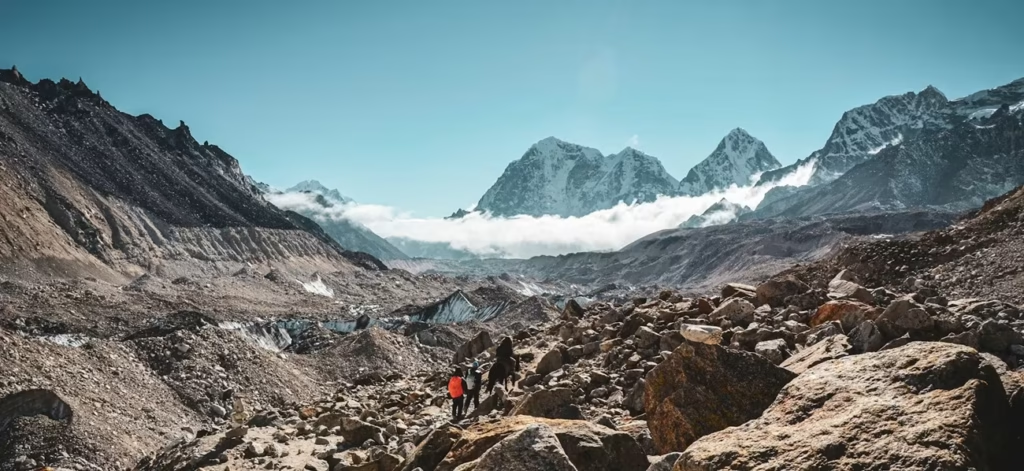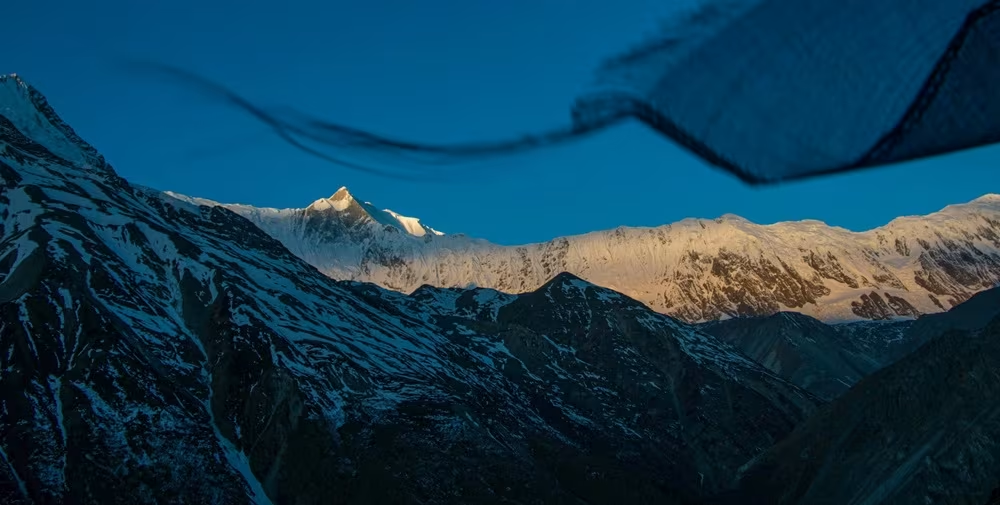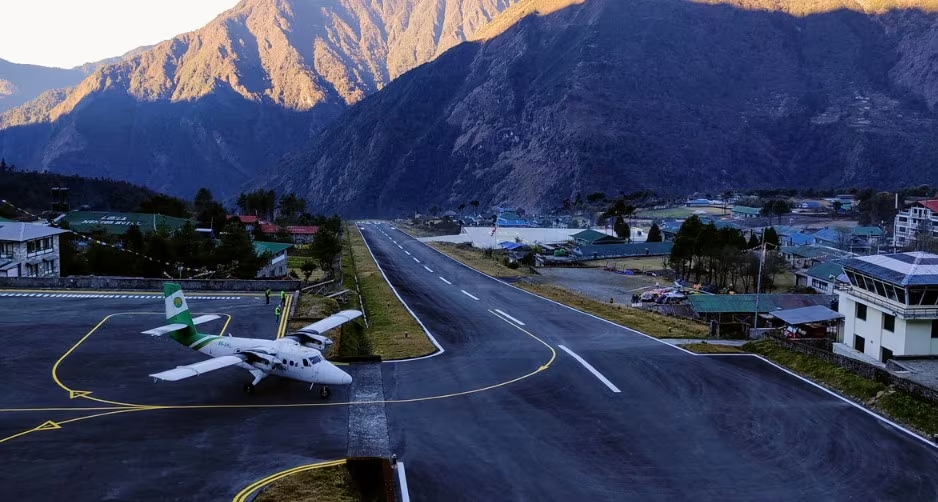Nepal offers two iconic adventures to the backpackers: Annapurna Base Camp (ABC) and the Everest Base Camp (EBC) trek. Though both journeys carry stunning views and of a one-of-a-kind experience, they are different in many ways.
This guide discusses the differences between the Annapurna Base Camp Trek vs Everest Base Camp Trek. This will help you to select the trek that best fits your preferences.
Annapurna Base Camp trek is located at 4,130 m elevation. Thus it is beginner friendly comparatively and easier for trekkers with concerns about high-altitude problems.
On the other hand, the Everest Base Camp Trek goes up to 5,364 meters. It takes more energy and endurance followed up by acclimatization. The Everest Base Camp has higher risks of altitude sickness than that of Annapurna Base Camp Trek.
Beyond that, the Annapurna and Everest Base Camp trek are also different in duration and terrain. The Annapurna route is usually shorter and less intense. On the contrary, the EBC trail is longer, much more difficult and requires intensive preparation.
Understanding the Annapurna Base Camp Trek vs Everest Base Camp, also helps you understand different landscapes and cultures. In this guide, we will go through all the details that ABC and EBC trek brings and how they differ from one another.
Comparing Altitude and Challenge Levels
Everest Base Camp Trek

The Everest Base Camp Trek takes you to an altitude of 5,364 meters (17,598 feet). Thus, it is one of the highest trekking routes in the globe. Many trekkers also reach Kala Patthar at an elevation of 5550 m (18,209 feet) for a gaze on the views of Mount Everest.
The journey starts in Lukla (2,860 meters). Then the uphill route stretches through Phakding and then rises via Namche bazaar (3,440 meters). Namche, known as the gate to Mt. Everest is a Sherpa town rich in culture and modern dynamics.
The trail takes trekkers to Dingboche (4,410 meters), Gorakshep, and finally to Everest Base Camp. Because of extreme elevations, trekkers must be careful about altitude sickness. Symptoms include headache, nausea, and dizziness.
Appropriate acclimatization and hydration are necessary to reduce these risks.
In terms of physical challenges, the EBC trail is not without challenges. The trail is about 80 to 85 miles (two-way), which can be completed in 12 to 14 days. It comes with steep ascents, rocky paths and glaciers.
Trekkers require good cardiovascular endurance and leg strength. There is no need for special technical climbing skills. However, this trek suits people who have previous trekking experience.
Annapurna Base Camp Trek: More Accessible

The Annapurna Base Camp Trek goes up to 4,130 meters (13,550 feet). It is lower than the EBC Route. The trail begins at Nayapul (1,070m) and goes through villages such as Ghorepani (2,874m) and Chhomrong (2,170m).
This trek is one of the best in Nepal. It lets trekkers enjoy the beauty of the Himalayas and the Gurung culture.
The Annapurna trek or ABC is regarded as moderately difficult. Covering around 110 km in distance, it takes around 7 to 12 days to complete.
The number of hours spent each day on treks of daily duration is the same as for trekking to the EBC. But the lower elevation and reduced length make it a better fit for first-time hikers.
In the meantime, acclimatization is advised to all trekkers even it is considered less challenging.
Scenic Beauty and Environment
Majestic Views

Everest Base Camp trek offers views of towering peaks, including Everest (8,848 meters), Lhotse, Nuptse, and Ama Dablam. Trekkers come across the cultural landmarks of the Khumbu region, such as the Tengboche Monastery. Also, they pass across the Imja Khola River with sublime views of snow-capped mountains.
The ideal time to hike to EBC is the Spring season. This time frame comes with clear skies and moderate temperature. The trek can also be done during autumn (September-November), which comes with rhododendron blossoms.
Annapurna Base Camp trek offers various scenery including terraced terrains, forest and alpine meadows. Trekkers can experience a close view of peaks such as Annapurna I (8,091 meters), Machapuchare, Hiunchuli and more.
Diverse Landscapes
The Everest Base Camp trek crosses many ecological zones. It starts at a temperate forest in Lukla and reaches the alpine tundra near the base camp.

Trekkers go through a change from lush green vegetation as they begin to enter rocky land covered with snow. Such a variation offers a complete Himalayan trek experience that reflects the environmental diversity of the region.
Likewise, the Annapurna trek presents a rich mosaic of environments. The trail cuts through the subtropical forests through the rhododendron grove to the high-altitude terrain.
Key Takeaway:
The Everest Base Camp trek provides a magnificent view of Mount Everest and alpine sceneries.
Annapurna Base Camp treks feature various types of landscapes, such as terraced fields and temperate forests.
Duration and Accessibility
The Everest Base Camp trek is normally 12-14 days and about 130 kilometres, round trip.
Trekkers begin their trekking adventure with an air flight from Kathmandu to Lukla. After that, they make a steady climb through the Khumbu region.
Almost all trek includes acclimatization in Namche and Dingboche to reduce the risk of altitude sickness. The Annapurna Base Camp trek takes 7 to 11 days depending on the route with acclimatization included.
Accommodation and Amenities
Accommodation during the Everest Base Camp trek comes in the form of teahouses. These basic huts provide food, shared rooms and communal toilets.
Some tea houses also offer hot showers and Wi-Fi for an extra charge.
The Annapurna Base Camp trek also includes tea house lodgings, particularly quite cozy in lower levels. These lodges provide basic necessities such as meals and shared rooms and some of these lodges have private bathrooms and hot showers.
As the treks go higher, the facilities are fewer. It is crucial to carry items such as sleeping bags and personal hygiene products.
Connectivity and Internet Access
During the Everest Base Camp trek, trekkers can expect limited access to the internet. Places like Namche have good chances of connections but other places have approximately no access. So it is wise to carry satellite phones.
Alternatively, trekkers can also carry Nepalese SIM Cards, such as NCELL and NTC for data connections. If that’s not in your option, you can have the Everest Link packages, which allows you to surf the internet in the Everest Region.
The Annapurna Base Camp trek also provides limited internet access. Though the availability of Wi-Fi in some tea houses prevail.
Key Takeaway:
- Accommodation: Both treks offer teahouse accommodation which becomes more basic at higher regards.
- Connectivity: Internet access is available but unreliable on both treks, adjust accordingly for lack of communication.
Budget and Expenses
The Everest Base Camp trek that lasts 12-14 days costs from $1,200 to $2,500 per person. This total price consists of the payment for permits, travelling to Lukla, room and meals, and support of a specified guide.
Budget trips cost from about $850; while luxury excursions can exceed $2,600 and provide additional amenities and better accommodations.
On the other hand, the Annapurna Base Camp trek cost is usually lower with a 7 to 12-day trip costing $600 to $1,000. The cost includes permits, accommodations, meals as well as services of a guide.
Cost-Effective Choice
If you are looking for a budget-friendly journey, the Annapurna Base Camp trek is the ideal option.
This trek lasts for only a week or 10 days, so you can travel with a limited budget as well. The tea houses and food costs are also relatively cheaper than the Everest Base Camp Trek.
Everest Base Camp trek lasts for a couple of weeks, requiring more budget than the ABC Trek.
To have a budget-friendly journey to both trekking destination, we encourage you to:
- Rent travel and trekking gears
- Stay in a local tea house
- Road travel than flight [if you are time-flexible]
- Travel with group
Risks and Safety Considerations
High Altitude Risks
During the Everest Base Camp trek, trekkers reach high altitudes where there is less oxygen level. Elevations at these levels also increase the risk of suffering from altitude sickness.
There are chances of being exposed to Acute Mountain Sickness (AMS), High Altitude Pulmonary Edema (HAPE) and High Altitude Cerebral Edema (HACE).
Trekkers may suffer a wide range of symptoms, from slight to severe medical emergencies such as headaches and nausea. These risks must be minimized by trekking slowly up. Aso, you must ensure to drink lots of water and give time to acclimatize by resting.
It is highly recommended that prior to beginning the trek medical advice is sought.
Although the Annapurna Base Camp trek reaches the highest elevation of 4130 meters (13550 feet), climbers are not completely immune from the risks of altitude sickness.
Expert Advice
You should see a doctor for a medical check-up before embarking on either of the treks. Both treks require endurance and strength. So before you set out, you must train regularly in cardiovascular activities and strength-building exercises.
The use of a licensed guide is safer because they are knowledgeable about altitude sickness. And they can provide the necessary first aid in case of emergencies. It can make your stay even safer if you have travel insurance that covers high-altitude activities.
Listen to your body while you trek. If you experience symptoms of altitude sickness, descend as soon as possible and get sufficient medical treatment.
Restrict your physical activity and assure yourself maximum rest along the trek. Keeping yourself well hydrated, consuming nutrient rich foods and having the right clothes would help avoid risks.
Treating safety as a priority should always guide you in your decisions when trekking.
Final Thoughts on Annapurna vs Everest Trek
Trekkers enjoy stunning sceneries and unique Himalayan experiences on both the Annapurna trek and the Everest trek.
The Everest Base Camp trek offers an opportunity to get on the lap of Mt. Everest. Similarly, the Annapurna Base Camp trek offers you a budget-friendly trail to experience spectacular views.
Ultimately, what will suit you best will depend on your level of experience, financial limitations and how long you have planned for the trek.
The Annapurna Base Camp is best to those looking for a budget-friendly and short journey. But the Everest Base camp trek is good to those trekkers who are looking for the himalayan adventure and thrill.
Frequently Asked Questions
Which trek is better for beginners?
If you are a beginner, we recommend you to take Annapurna Base Camp Trek. Since this trek is much shorter than Everest base camp and takes to less altitude, it is quite preferable for the first-time travelers.
Do I need a guide or porter for these treks?
Yes, hiring guides is compulsory while trekking to remote Nepal. They help you in navigation and cultural immersion. Similarly, porters help you in carrying your trekking gears, making the journey more enjoyable.
What permits are required for these treks?
For EBC Trek, you need Sagarmatha National Park Entry and Khumbu Pasang Lhamu Municipality entry permit. Similarly, for Annapurna Sanctuary Trek, you need Annapurna Conservation Area Entry Permit and TIMS (Trekkers’ Information Management System) Card.
How do I prepare for high-altitude trekking?
You must be physically prepared for both of these treks. It is recommended to take cardiovascular exercises and altitude-exposure training.
What is the best time of year to trek in these regions?
The best time to trek in these regions are during the Spring and Autumn seasons. These seasons come with moderate temperature, favorable weather conditions, and clear views of the surrounding.
Is the Everest trek better than the Annapurna trek?
It differs on the preferences and interests of trekkers. While both treks promise you the natural wonders and cultural richness, the definition of which trek is best differs solely from one trekker to another.
Is Annapurna harder than Everest?
Considering the physical requirements, Annapurna trek is less hard than Everest Trek since the trek duration is short.
Why do people love Annapurna more than Everest?
Since Annapurna Trek is more budget-friendly and short, most people love Annapurna Trek more than Everest Trek.
Which is harder, EBC or ABC?
EBC Trek is much harder than ABC as it takes hikers to 5000 meters above sea level, which is 1000 meters higher than the ABC Trek. Similarly, the trekking duration is longer in EBC than ABC.
